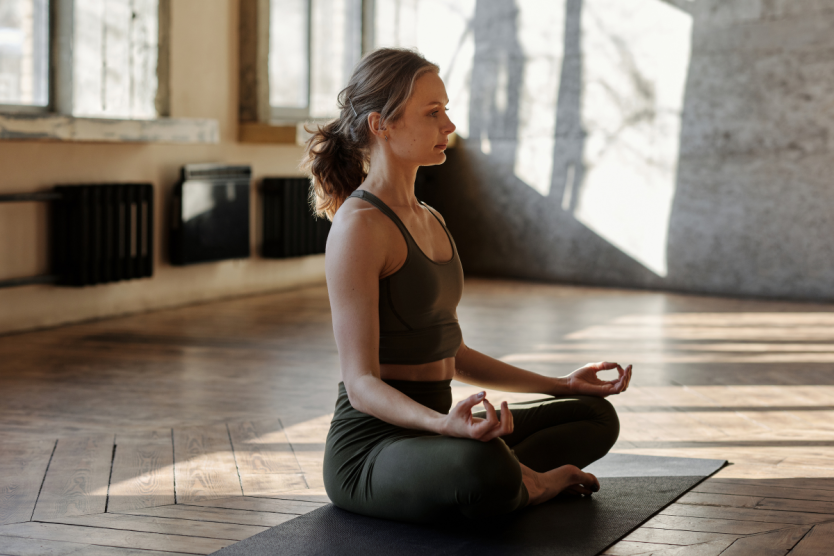Women have specific health needs, and can take specific steps to look after those needs.
Pelvic floor health is one example. The pelvic floor muscles are important enough that it’s worth looking after them. Besides Kegel exercises, what are some good workouts for women who want to strengthen their pelvic floor?
Yoga is a great regimen for women for many reasons, one of them being the benefits to your core muscles and others that support your pelvis.
Let’s look at good yoga exercises to support your core and pelvic floor.
Why Is Yoga Good For You?
The combination of breathing and stretching that we know as yoga is often cited as being beneficial to mental health – a way to increase our overall well being.
Studies have found that yoga practitioners show less anxiety, stress and fear, and have better coping strategies than those who do not practice yoga.1 As well, a study that incorporated an 8-week hatha yoga intervention resulted in significant reductions in the severity of depression in adults with mild-to-moderate major depression.2
How Can Yoga Help the Pelvic Floor Muscles
There are physical benefits to yoga, too, including specific enhancements to the muscles of the pelvic floor. A three-month yoga practice provides “preliminary evidence of reduction” in total and stress-type incontinence frequency in a group of women.3
And then there are the benefits of yoga in pelvic floor rehabilitation after childbirth. That’s one of the main causes for a common pelvic issue, pelvic organ prolapse. Yoga has shown to have a significant improvement on the physical health of postpartum women, such as vagina and pelvic floor muscle tension and elasticity, helping to prevent prolapse, urinary incontinence and other pelvic floor disorders. It also helped the mental health of postpartum women.4
3 Good Yoga Exercises To Get You Started
So we know that yoga can make a difference, particularly when taught with attention to women’s needs.3 It’s important to find and engage the pelvic muscles, which can be done with yoga and breathing.5
If you’re ready to exercise at home and strengthen your pelvic floor, here are 3 good yoga exercises to get you started:
1. Constructive Rest: Savasana or corpse pose is usually the conclusion of a yoga session. It’s relaxing but can be done with a purpose, too. You simply lay on your back with your arms and legs relaxed (like a corpse). To relieve pressure on your back, bend your knees and place your feet flat on the floor. Rest both hands on your belly and tune into your breath. Inhale and exhale, engaging your ab muscles at the end of the exhalation. This will engage your core and your pelvic floor muscles.5
2. Happy baby: While you’re laying down, give your back a little massage while benefitting your pelvic floor. Bring your knees toward your armpits, and grab the outside of your feet with your hands. If you can’t reach, you can also grab behind your thighs. Then tighten your abs by pressing your belly button to your spine, and pull up the pelvic floor muscles as you would in a Kegel exercise. Rock from side to side (like a baby would) to massage your back. Hold for as long as you feel comfortable and repeat several times.6
3. Cat-Cow: Flip over onto all fours, and place your hands under your shoulders and knees under your hips. Inhale and arch your back like a cat, tilting the pelvis forward. Then exhale into cow pose by dropping your tailbone and curving your back in the opposite direction. This can also help release tension in your back.5
While doing any of these exercises, focus on your breathing and how you engage the pelvic floor with your breath. Inhale and keep your pelvic floor relaxed, then exhale and engage your pelvic floor by lifting it, just as you would to prevent passing gas or urinating.7
Take It Slow
These are a few basic yoga poses that don’t involve too much physical exertion, but like any physical activity, it’s worth checking with your doctor before starting a program.
If you have a specific pelvic condition, you should seek medical advice. For instance, any kind of pelvic pain or dysfunction may be helped by pelvic floor physical therapy. If you’re suffering from a prolapse, there are some exercises that you should not be doing.
Start by finding a qualified doctor near you, and get some guidance on your pelvic health.
















